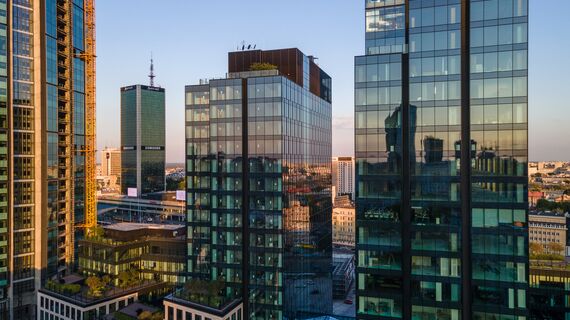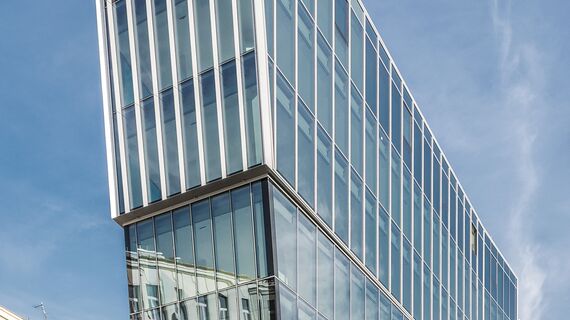- Konior & Partners
- Atelier 2 Architekci
Marynarska Business Park
When it comes to solutions, the architects behind the Marynarska Business Park, Konior & Partners of Brussels and Atelier 2 Architekci of Warsaw, firmly believe in the tried and tested. Their recently completed office complex in Poland’s capital is the best example of this. An axial layout, a classically-organised elevation and a typical plan make for a design with a dual aim: on the one hand creating an impression of architectural prestige and urban monumentality and, on the other, guaranteeing the greatest possible versatility in everyday use.
The Marynarska Business Park stands in Służewiec, part of Warsaw’s Mokotów district. This is an area which is currently undergoing a transformation from the ground up. After decades of clamour emerging from its various factories and warehouses, all working round the clock, it is now primarily becoming a centre of expertise. Owing to the proximity to the main arterial routes and Okęcie Airport and shopping centres as well as the excellent access to public transport, a myriad of huge office buildings have now been built where industrial plants once stood. In terms of urban planning, the office complex has an axial layout which is comprised of four parts with several modifications. The architects have broken up a letter “C” layout, classic in the spatial and functional sense, in several ways, giving each part a different height, separating one part entirely and twisting it to bring it closer to the main road. They have also designed two powerful articulated gates which are not, as it transpires, entrances to the building but the entrance and exit to the car park. They have succeeded in achieving a diversified development, linked by a stunning approach from the circular fountain in the centre and the several rows of parking spaces situated around it. The entire complex consists of a useable area of almost 45,000 m². Its division into four components, which can be linked to a certain extent, together with the typical planning of the stairs, elevators and sanitary facilities in the central part, make the layout simple and accessible for a variety of users. The central space, with its separate corridor, has a depth somewhat in excess of 7 metres and offers a range of excellent working conditions, both in terms of natural light and the view over the city and in terms of the sophisticated technology used to control not only the temperature, but also the building’s overall functioning. Though each of the four parts has its own entrance and reception area, they are linked by a huge, three storey underground car park with the capacity to hold 1,300 cars.
Big figures
The integration of the entire development is indisputably achieved not merely by means of the circular fountain, but by the leitmotif of the elevation’s rhythm and materials. Classic in terms of layout, the ground floor is recessed and supported by massive-looking, aluminium columns and the top storey is similarly recessed, with the light, airy projection of the roof providing an additional accent. Meanwhile, between the two lies the main body of the building: a smooth, glass surface, a few sandstone highlights and a central section bisected by an additional loggia. The façades are inarguably horizontal in nature, rendering the number of the storeys making up the complex’s component parts in the language of graphics. Big figures: The 14.5 km of columns, 16.5 km of spandrel beams and a multitude of other elements, all manufactured by Reynaers Aluminium, support the 850-tonne, 20,000 m² of Strathophon elevation glass, protecting the interior from excessive noise. A structural glazed façade structure was used throughout, together with a post and beam façade in both the classic and the CW 50 curtain wall versions. Special profiles were also created specifically for the Marynarska Business Park. They include reinforced frames and huge pivot window casements and special elements, allowing the suspension of both the decorative masking frames and the masking frames themselves. The building complex, curved around a prominent corner, is also distinguished by its extended elevations at the two ends visible from the street. Suspended in the air, the sheet of glass gives the Marynarska a sense of transparency, extending the reach of its top storey to 5 metres. In giving the impression that the building has grown wings, this feature links it to Warsaw’s nearby airport. It is thus that the Marynarska Business Park attains a lightness, whilst still remaining a monumental structure.
Used systems
Involved stakeholders
Architect
- Konior & Partners
- Atelier 2 Architekci
Photographer
- Jarosław Kąkol
Other stakeholder
- Ghelamco Poland (General contractors)









